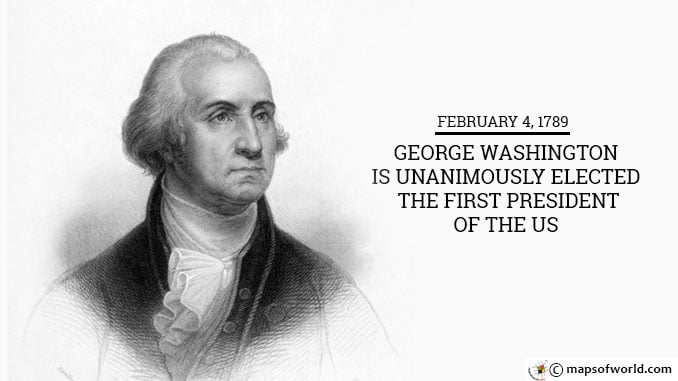On February 4, 1789, George Washington was elected to be the first President of the United States of America – the only president to have won unanimously at the presidential elections. During the course of his military career, Washington had earned a formidable reputation. He had served during the Seven Years’ War and was referred to as the “Colonel of the Virginia Regiment and Commander in Chief of all forces now raised in the defense of His Majesty’s Colony”. His powerful leadership became evident as the original colonies started to resist the British. Apart from representing Virginia at the Continental Congress, he put his military acumen to good use as the commander-in-chief of the Continental Army during the Revolutionary War. He trained troops and led the colonies to victory. George Washington’s strong conviction in democratic principles became evident when he vehemently rejected a suggestion that his popularity as a leader entitled him to assume the nation’s dictatorship. Following the Revolutionary War, he also played a leading role in drafting the American constitution. The 69 electors, who formed the Electoral College of the first American presidential elections, represented 10 of the 13 original states (only 11 of the 13 had ratified the US Constitution at the time). These electors had been chosen by legislative appointment, popular vote, or at times by a combination of both about a month before the election. New York was not represented since it had failed to choose its eight presidential electors. Difficult weather conditions delayed the attendance of two electors each from Virginia and Maryland and they did not cast a vote. North Carolina was to have seven electors and Rhode Island three electors but remained unrepresented at the presidential elections as the states had not ratified the Constitution. Each of the 69 electors was allowed to cast two votes with two choices for president – the ballots did not bear a distinction between the elector’s choice for president and vice president. Washington was chosen by all 69 electors. John Adams from Massachusetts got 34 votes and became Vice President. The other presidential candidates in the election were John Jay from New York (9 votes), Robert Harrison from Maryland (6 votes), John Rutledge from South Carolina (6 votes), John Hancock from Massachusetts (4 votes), George Clinton from New York (3 votes), Samuel Huntington from Connecticut (2 votes), John Milton from Georgia (2 votes), James Armstrong from Pennsylvania, Edward Telfair from Georgia, and Benjamin Lincoln from Massachusetts (one vote each). George Washington was informed of his victory at the presidential polls in April. By the end of the month, Washington crossed the Hudson River in a specially done up barge. He took his oath amidst much cheer on the balcony of Federal Hall on Wall Street. His inaugural address spoke of great aspirations for the nation and emphasized the need for integration. He also set an exemplary example for the future presidents. He had once commented, “I walk on untrodden ground. There is scarcely any part of my conduct which may not hereafter be drawn in precedent.” He was a powerful diplomat and a compassionate leader. In 1792, again on February 4, George Washington was unanimously reelected to the president’s office with all 132 votes. Adams again became the Vice President with 77 votes. Washington refused to contest for a third term. This system of undifferentiated voting by the Electoral College, however, did not sustain Washington’s departure from the political scenario. In 1796, the supporters of John Adams cast only one of their two votes to enable him to bag the presidency without much rivalry. While Adams did win the highest number of votes and became the president, Thomas Jefferson his rival Democratic-Republican candidate became the Vice President. In 1800, due to a tie between Thomas Jefferson and Aaron Burr, the House of Representatives was called to vote. The Congressional vote was cast 35 times and each time it returned a tie. At last the Federalists handed in blank ballots and Jefferson became the President. The 12th Amendment to the Constitution in 1804 brought an end to such the challenges posed by the system by stipulating that the votes for president and vice president be cast separately. You may also like : February 4 1945 – Winston Churchill, Franklin D. Roosevelt and Joseph Stalin Gather for the Yalta Conference
February 4 1789 – George Washington is unanimously elected the first President of the US
On February 4, 1789, George Washington was elected to be the first President of the United States of America – the only president to have won unanimously at the presidential…
734
